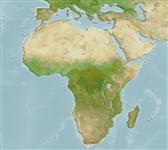Common names from other countries
Environment: milieu / climate zone / depth range / distribution range
Écologie
; profondeur 20 - 40 m (Ref. 122059). Subtropical; 34°S - 33°S, 18°E - 27°E (Ref. 4)
Distribution
Pays | Zones FAO | Écosystèmes | Occurrences | Introductions
Eastern Atlantic: South Africa and UK.
Length at first maturity / Taille / Poids / Âge
Maturity: Lm ? range ? - ? cm Max length : 12.9 cm TL mâle / non sexé; (Ref. 122061); 9 cm TL (female); common length : 10.0 cm TL mâle / non sexé; (Ref. 4)
It has a total body length of 8 to 10 cm; and a carapace length of 4 to 5 cm (Ref. 4). Occurs at shallow coastal waters, rock pools (Ref. 4).
Life cycle and mating behavior
Maturité | Reproduction | Frai | Œufs | Fécondité | Larves
Members of the order Decapoda are mostly gonochoric. Mating behavior: Precopulatory courtship ritual is common (through olfactory and tactile cues); usually indirect sperm transfer.
Holthuis, L.B. 1991. (Ref. 4)
Statut dans la liste rouge de l'IUCN (Ref. 130435)
statut CITES (Ref. 108899)
Not Evaluated
Not Evaluated
Utilisations par l'homme
Pêcheries: sans intérêt
| FishSource |
Outils
Plus d'informations
Taille/ÂgeCroissanceLongueur-poidsLongueur-longueurMorphologieLarvesAbondance
Sources Internet
Estimates based on models
Catégorie de prix
Unknown.
